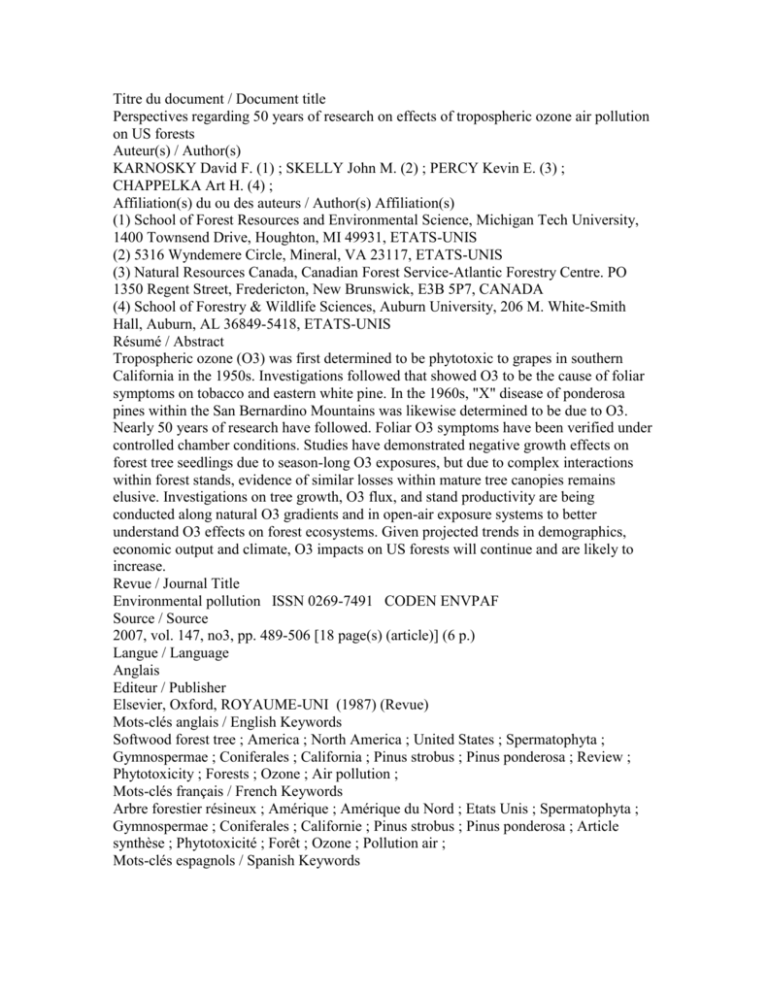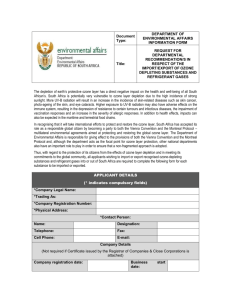
Titre du document / Document title
Perspectives regarding 50 years of research on effects of tropospheric ozone air pollution
on US forests
Auteur(s) / Author(s)
KARNOSKY David F. (1) ; SKELLY John M. (2) ; PERCY Kevin E. (3) ;
CHAPPELKA Art H. (4) ;
Affiliation(s) du ou des auteurs / Author(s) Affiliation(s)
(1) School of Forest Resources and Environmental Science, Michigan Tech University,
1400 Townsend Drive, Houghton, MI 49931, ETATS-UNIS
(2) 5316 Wyndemere Circle, Mineral, VA 23117, ETATS-UNIS
(3) Natural Resources Canada, Canadian Forest Service-Atlantic Forestry Centre. PO
1350 Regent Street, Fredericton, New Brunswick, E3B 5P7, CANADA
(4) School of Forestry & Wildlife Sciences, Auburn University, 206 M. White-Smith
Hall, Auburn, AL 36849-5418, ETATS-UNIS
Résumé / Abstract
Tropospheric ozone (O3) was first determined to be phytotoxic to grapes in southern
California in the 1950s. Investigations followed that showed O3 to be the cause of foliar
symptoms on tobacco and eastern white pine. In the 1960s, "X" disease of ponderosa
pines within the San Bernardino Mountains was likewise determined to be due to O3.
Nearly 50 years of research have followed. Foliar O3 symptoms have been verified under
controlled chamber conditions. Studies have demonstrated negative growth effects on
forest tree seedlings due to season-long O3 exposures, but due to complex interactions
within forest stands, evidence of similar losses within mature tree canopies remains
elusive. Investigations on tree growth, O3 flux, and stand productivity are being
conducted along natural O3 gradients and in open-air exposure systems to better
understand O3 effects on forest ecosystems. Given projected trends in demographics,
economic output and climate, O3 impacts on US forests will continue and are likely to
increase.
Revue / Journal Title
Environmental pollution ISSN 0269-7491 CODEN ENVPAF
Source / Source
2007, vol. 147, no3, pp. 489-506 [18 page(s) (article)] (6 p.)
Langue / Language
Anglais
Editeur / Publisher
Elsevier, Oxford, ROYAUME-UNI (1987) (Revue)
Mots-clés anglais / English Keywords
Softwood forest tree ; America ; North America ; United States ; Spermatophyta ;
Gymnospermae ; Coniferales ; California ; Pinus strobus ; Pinus ponderosa ; Review ;
Phytotoxicity ; Forests ; Ozone ; Air pollution ;
Mots-clés français / French Keywords
Arbre forestier résineux ; Amérique ; Amérique du Nord ; Etats Unis ; Spermatophyta ;
Gymnospermae ; Coniferales ; Californie ; Pinus strobus ; Pinus ponderosa ; Article
synthèse ; Phytotoxicité ; Forêt ; Ozone ; Pollution air ;
Mots-clés espagnols / Spanish Keywords
Arbol forestal resinoso ; America ; America del norte ; Estados Unidos ; Spermatophyta ;
Gymnospermae ; Coniferales ; California ; Pinus strobus ; Pinus ponderosa ; Artículo
síntesis ; Fitotoxicidad ; Bosque ; Ozono ; Contaminación aire ;
Mots-clés d'auteur / Author Keywords
O3 ; Interacting multiple stresses ; Forest ecosystems ; Black cherry ; Eastern white pine ;
Aspen ; Ponderosa pine ;
Localisation / Location
INIST-CNRS, Cote INIST : 15173, 35400014959283.0060
Copyright 2008 INIST-CNRS. All rights reserved
Toute reproduction ou diffusion même partielle, par quelque procédé ou sur tout support
que ce soit, ne pourra être faite sans l'accord préalable écrit de l'INIST-CNRS.
No part of these records may be reproduced of distributed, in any form or by any means,
without the prior written permission of INIST-CNRS.
Nº notice refdoc (ud4) : 18752923
Northeastern Naturalist
Article: pp. 221–236 | Abstract | PDF (1.69M)
TROPOSPHERIC OZONE AND ITS IMPORTANCE TO FORESTS AND NATURAL
PLANT COMMUNITIES OF THE NORTHEASTERN UNITED STATES
John M. Skelly
Ozone is a secondary air pollutant formed under conditions of bright sunlight and warm
temperatures as a result of photochemical reactions involving nitrogen oxides and
hydrocarbons as primary precursor pollutants. Tropospheric ozone is of regional-scale
importance due to long-range transport of polluted air masses from urban and industrial
areas of the Midwest and Northeast into agricultural and forested regions situated
downwind of these expansive source regions. Ozone is perhaps the most important air
pollutant of concern to the long-term productivity and health of trees and other native
plants which comprise our natural and forested areas of the Northeast. On broadleaf
species, foliar injury is exhibited as a stipple and/or more general pigmentation of the
upper leaf surface late in the growing season. These symptoms are considered to be the
best response parameter to observe and relate to ambient ozone exposures; ozone-induced
injuries on conifers are more difficult to diagnose. Several plant species are known as
bioindicators of ozone exposures; symptom observations from a recent open-top chamber
investigation in central Pennsylvania confirm black cherry, yellow poplar, white ash,
common milkweed, spreading dogbane, and blackberry to be sensitive to ambient ozone
exposures. Concerns for lack of ozone air pollution monitoring in remote forested areas
and more complete understanding of the effects to tree species and other native plants are
discussed.
Regional Assessment of Ozone Sensitive Tree Species Using Bioindicator Plants
Authors: Coulston J.W.1; Smith G.C.2; Smith W.D.3
Source: Environmental Monitoring and Assessment, Volume 83, Number 2, April 2003 ,
pp. 113-127(15)
Publisher: Springer
* next article >
*|
* view table of contents
Key:
Free Content - Free Content
New Content - New Content
Subscribed Content - Subscribed Content
Free Trial Content - Free Trial Content
Abstract:
Tropospheric ozone occurs at phytotoxic levels in the northeastern and mid-Atlantic
regions of the United States. Quantifying possible regional-scale impacts of ambient
ozone on forest tree species is difficult and is confounded by other factors, such as
moisture and light, which influence the uptake of ozone by plants. Biomonitoring
provides an approach to document direct foliar injury irrespective of direct measure of
ozone uptake. We used bioindicator and field plot data from the USDA Forest Service to
identify tree species likely to exhibit regional-scale ozone impacts. Approximately 24%
of sampled sweetgum (Liquidambar styraciflua), 15% of sampled loblolly pine (Pinus
taeda), and 12% of sampled black cherry (Prunus serotina) trees were in the highest risk
category. Sweetgum and loblolly pine trees were at risk on the coastal plain of Maryland,
Virginia and Delaware. Black cherry trees were at risk on the Allegheny Plateau
(Pennsylvania), in the Allegheny Mountains (Pennsylvania, West Virginia, and
Maryland) as well as coastal plain areas of Maryland and Virginia. Our findings indicate
a need for more in-depth study of actual impacts on growth and reproduction of these
three species.
Keywords: air pollution; monitoring; northeastern United States; risk assessment; spatial
analysis
Language: English
Document Type: Research article
Affiliations: 1: Department of Forestry, North Carolina State University, Southern
Research Station, U.S. Forest Service, Research Triangle Park, North Carolina, U.S.A.;
(author for correspondence, e-mail: jcoulston@fs.fed.us) 2: Department of Natural
Resources Conservation, University of Massachusetts, Amherst, Massachusetts, U.S.A.
3: U.S. Forest Service, Research Triangle Park, North Carolina, U.S.A.
People who read this article also read...
Joint Commission Perspectives, July 2008, vol. 28, no. 7
download full issue, joint commission perspectives july 2008 vol. 28 no. 7, joint
commission perspectives, joints, perspectives
1206 people looked at this
Joint Commission Perspectives, September 2008, vol. 28, no. 9
download full issue, full issue, joint commission perspectives, signs, sign in
493 people looked at this
Joint Commission Perspectives, August 2008, vol. 28, no. 8
download full issue, full issue, signs, sign in, joint commission perspectives
374 people looked at this
powered by Baynote
The full text electronic article is available for purchase. You will be able to download the
full text electronic article after payment.
$42.00 plus tax
Credit/debit card Institutional payment account
Author information
First Name
LastName
Kent O Burkey KO
Joseph E
Miller JE
Edwin L
Fiscus EL
Initials
Affiliation: USDA-ARS Plant Science Research Unit, Department of Crop Science,
North Carolina State University, Raleigh, NC 27607, USA. koburkey@unity.ncsu.edu
Grants:
Journal and publication information
Publication Type: Journal Article
Journal: Journal of environmental quality (J Environ Qual).
Reference: -2005 May-Jun; vol 34 (issue 3) : pp 1081-6
Language: eng
PMID: 15888894 (status: MEDLINE) (last retrieval date: 2/6/2008)
External Links for this article (including full text providers, if available):
For links to sites providing the full text of this article and related topics see links. Note
there may be a subscription or fee required for access to the full text. See our FAQ for
information on finding FREE full text articles.
MeSH headings (categories)
Research article summary:
Free Full Text!
See links below
Assessment of ambient ozone effects on vegetation using snap bean as a bioindicator
species.
Full Abstract
Tropospheric ozone is an air pollutant that is toxic to plants, causing visible injury to
foliage and a reduction in growth and yield. The use of plant bioindicators is one
approach to assess the ozone impacts in diverse geographical areas. The objective of this
study was to evaluate snap bean (Phaseolus vulgaris L.) as a potential bioindicator
species. Three snap bean genotypes known to exhibit a range of ozone sensitivity were
grown in pots under charcoal-filtered (CF) or nonfiltered (NF) treatments in open-top
chambers, or under ambient air (AA) conditions. Treatment effects on biomass were not
significant at 56 days after planting (DAP), but midseason foliar injury increased in the
NF and AA treatments relative to CF controls. An increase in ozone from 25 to 30 nL L(1) in CF controls to approximately 50 nL L(-1) in the NF and AA treatments was found
to suppress final pod dry weight per plant by 40 to 60% in the most sensitive genotype
S156. The same treatments suppressed final pod dry weight by 20 to 30% in a moderately
sensitive genotype Oregon-91, and by 10% or less in a tolerant genotype R123. An S156
to R123 yield ratio of approximately one was observed under CF conditions. The S156 to
R123 yield ratio declined to 0.6 to 0.7 in the NF treatment and declined further to 0.4 to
0.5 in the AA treatment, suggesting that ozone impact was underestimated in the opentop chambers. The results suggest that a snap bean bioindicator system has the potential
to detect ambient ozone effects at present-day ozone concentrations.







